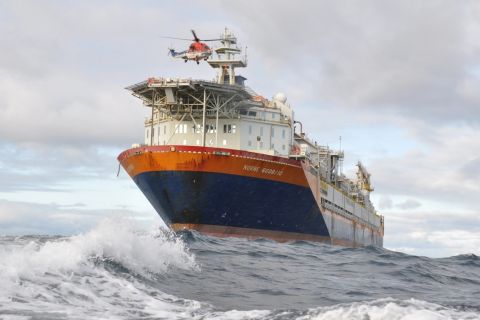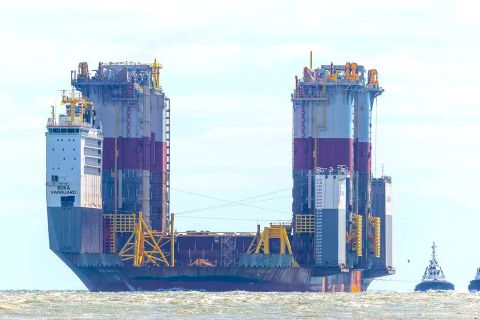Geologically reasonable, data-driven velocity model building is critical for a seismic imaging project. This approach might struggle when the velocity is strongly heterogeneous, which is especially noticeable when gas pockets distort imaging with anomalously low velocities and high attenuation. Shallow gas may disrupt a significant portion of the imaged depth. A successful workflow for an imaging project is presented in this article, which shows these types of anomalies in otherwise orderly shallow sediment. Refraction and reflection-based full-waveform inversion (FWI) generates high-resolution velocity contrasts, and alternating iterations of image-guided tomography resolve bulk travel time errors. This produces a geologically constrained velocity model with very high-contrast features at the imaged anomalous regions, leading to obvious uplift in deeper sediments.
Multistage FWI approach
FWI produces model updates by comparing observed and modeled shot gathers, and multistage approaches avoid some of the inherent difficulties of this method. The initial model may be significantly incorrect during early diving wave FWI updates, leading to the likelihood of cycle-skipping errors. These can be mitigated by conditioning data with a dynamic-warping algorithm for diving wave FWI while generating large-scale model updates. Higher-resolution updates are encouraged by incorporating reflected data with updates conditioned by image-guided smoothing for phase-only reflection FWI.
Multistage FWI yields high-resolution, realistic contrasts across imaged structural interfaces. However, common-image gathers may show significant residual moveout, suggesting that the velocity model still needs consideration. This can be corrected with a tomographic scheme using nonparameterized moveout picking and image-guided inversion to encourage data-driven high-resolution updates. Image-guided tomography enforces structural conformance, automatically respecting imaged layers and faults, making it an ideal counterpart to FWI to provide background, low-frequency updates at early iterations, but also to bolster necessary high-resolution velocity contrasts to isolate anomalous regions.
The multistage FWI workflow encourages each algorithm to focus on its strengths:
• Low-resolution tomography yields major velocity features, correcting significant signal mismatch in modeled and observed common shot gathers for subsequent FWI;
• Dynamic warping and image-guided diving wave FWI begin to isolate anomalous regions within layers;
• Common-image gather residual moveout is now more easily picked for image-guided tomography to obtain correct depths around shallow anomalous features;
• Image-guided phase-only reflection FWI adds high-resolution details to anomalies, better separating their low velocities from the sedimentary trend; and
• High-resolution image-guided tomography fixes remaining travel time errors and helps define the velocity anomalies.
This process of alternating FWI and tomography while increasing resolution may proceed until the desired convergence is reached. For focused common-image gathers, the final step should always be a tomographic update.
Case study
This workflow was applied to the 6,500-sq-km (2,510-sq-mile) 2017 narrow azimuth 3-D Crean survey off the western coast of Ireland. Initial imaging reveals neatly structured shallow sediment down to a thick chalk layer about 3.5 km (2.2 miles). As seen in Figures 1 and 2, this region is contaminated by anomalies characterized by significant sags in underlying layers due to severely compromised events in common-image gathers, suggesting sharp velocity contrasts. The impact of these anomalies can be observed more than 2 km (1.2 miles) below their upper bounds. Image-guided tomography is a robust method for these kinds of imaging issues, but initial reflection data are so poor that diving wave FWI is necessary to recover strong velocity contrasts in these low-velocity, poorly illuminated regions.


Model building alternates updates from tomography and FWI. Long-wavelength model updates are provided by Iteration 1 tomography. Iteration 2 consists of low-resolution diving wave FWI to isolate the anomalous regions, which has well-imaged upper bounds. Iteration 3 tomography improves overall gather event flatness. Iteration 4 reflection FWI nearly finalizes the character of the model around the anomaly, and Iteration 5 tomography corrects minute residual moveout
errors around and below the anomaly.
Initial common-image gathers in Figure 2 demonstrate complex residual moveout around the anomalous region due to the smooth initial velocity model. The progression from low- to high-frequency updates by alternating tomography and FWI brings events into better focus, with each update providing an improved base for the subsequent steps. Final gathers are well-focused
across all offsets.
Imaging improvement is driven by the ultraslow velocities derived within the anomaly, typically 500 m/sec (1,640 ft/sec) slower than surrounding velocity and tied strongly to the imaged boundaries. Despite this anomalous update being constrained shallower than 3 km (1.8 miles), the impact is seen to a depth of at least 4.5 km (2.8 miles). The structure through and below the
chalk layer is more reasonable, and event continuity is improved despite dominant low frequencies. The final tomographic update begins to resolve deeper structure due to the detailed shallow model building.
Hybrid high-resolution FWI and tomographic model building rely on the strengths of each approach. FWI generates model contrasts by isolating the relative shot gather differences along events. This is crucial early in the model building process when refracted energy is more reliable
than reflections. Tomography cannot independently find these contrasts in poor signal areas, particularly around strongly anomalous velocity features, but can correct overall residual moveout to enhance event focusing. Alternating FWI and tomographic passes highlight these benefits while reducing the uncertainties of each.
References available. Contact Jennifer Presley at jpresley@hartenergy.com.
Recommended Reading
Vår Selling Norne Assets to DNO
2024-05-08 - In exchange for Vår’s producing assets in the Norwegian Sea, DNO is paying $51 million and transferring to Vår its 22.6% interest in the Ringhorne East unit in the North Sea.
SLB OneSubsea JV to Kickstart North Sea Development
2024-05-07 - SLB OneSubsea, a joint venture including SLB and Subsea7, have been awarded a contract by OKEA that will develop the Bestla Project offshore Norway.
EOG: Utica Oil Can ‘Compete with the Best Plays in America’
2024-05-09 - Oil per lateral foot in the Utica is as good as top Permian wells, EOG Resources told analysts May 3 as the company is taking the play to three-mile laterals and longer.
Chevron, Total’s Anchor Up and (Almost) Running
2024-05-07 - During the Offshore Technology Conference 2024, project managers for Chevron’s Anchor Deepwater Project discussed the progress the project has made on its journey to reach first oil by mid-2024.
Private Equity Looks for Minerals Exit
2024-07-26 - Private equity firms have become adroit at finding the best mineral and royalties acreage; the trick is to get public markets to pay more attention.





